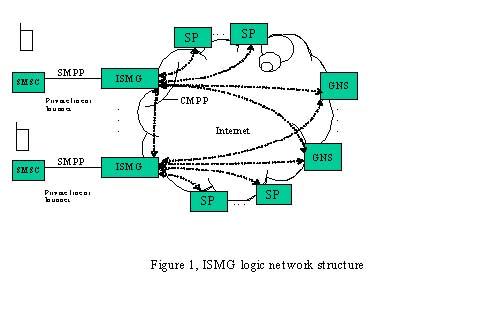ISMG概述协议网络结构介绍
ISMG概述协议网络结构介绍
中国移动通信互联网短信网关接口协议网络结构和功能概述
网络结构 Network Structure

如图1所示,互联网短信网关(ISMG)是外部信息资源站实体(SP)与移动网内短信中心之间的中介实体,互联网短信网关一方面负责接收SP发送给移动用户的信息和提交给短信中心。另一方面,移动用户点播SP业务的信息将由短信中心通过互联网短信网关发给SP。另外,为了减轻短信中心的信令负荷,互联网短信网关还应根据路由原则将SP提交的信息转发到相应的互联网短信网关。互联网短信网关通过向汇接网关(GNS)查询的方式获得网关间的转发路由信息。
As shown in Figure 1, ISMG is a medium entity between an external information resource station entity (SP) and the SMSC within the mobile network. On one hand, ISMG is required to receive messages sent by SP to mobile users, and submit them to SMSC. On the other hand, messages of mobile users ordering SP services will be sent by SMSC to SP via ISMG. In addition, to reduce the signaling load of SMSC, ISMG shall also forward messages submitted by SP to the corresponding ISMG according to the route principles. ISMG makes a query to the tandem gateway (GNS), and by doing so gets the forwarding route messages between gateways.
CMPP功能概述 Overview of CMPP Function
CMPP协议主要提供以下两类业务操作:
CMPP mainly provides the following two types of service operations:
1. 短信发送Message sending(Short Message Mobile Originate,SM MO)
The typical service operations are illustrated in Figure 2:
1) 手机发出数据请求(可能是订阅信息或图片点播等),被源ISMG接收;
The handset sends out a data request (that could be ordering a message or picture) that is received by the source ISMG;
2) 源ISMG对接收到的信息返回响应;
The source ISMG returns a response for the message received;
3) 源ISMG在本地查询不到要连接的SP,向GNS(汇接网关)发路由请求信息;
The source ISMG sends to GNS (tandem gateway) a route request message when it cannot find the SP to be connected in the local area;
4) GNS将路由信息返回;
GNS returns the routing message;
5) 源ISMG根据路由信息将请求前转给目的ISMG;
The source ISMG forwards the request to the destination ISMG according to the routing message;
6) 目的ISMG对接收到的信息返回响应;
The destination ISMG returns a response for the message received;
7) 目的ISMG将请求信息送SP.
The destination ISMG submits the request information to SP;
8) SP返回响应;
SP returns a response.
在以上操作中,步骤3到步骤8均使用CMPP协议;
CMPP is used from Step 3 to Step
在随后的操作中,目的ISMG在接收到SP的响应后将产生MO状态报告发给源ISMG。
In the succeeding operations, the destination ISMG will generate a MO status report and send it to the source ISMG after it has received the response from SP.
2. 短信接收Message receiving(Short Message Mobile Terminated,SM MT)
The typical service operations are illustrated in Figure 3:
1) SP发出数据请求(可能是短信通知或手机短信等),被源ISMG接收;
SP sends out a data request (that could be a message alert or handset ring) that is received by the source ISMG;
2) 源ISMG对接收到的信息返回响应;
The source ISMG returns a response for the message received;
3) 源ISMG在本地数据库中找不到目的手机号段所对应网关代码,向GNS(汇接网关)发路由请求信息;
The source ISMG sends a route request message to GNS (tandem gateway) when it cannot find the gateway code correspondent to the destination mobile number segment in the local database;
4) 汇接网关将路由信息返回;
The tandem gateway returns the routing message;
5) 源ISMG根据路由信息将请求前转给目的ISMG;
The source ISMG forwards the request to the destination ISMG according to the routing message;
6) 目的ISMG对接收到的信息返回响应;
The destination ISMG returns a response for the message received;
7) 目的ISMG将请求信息发送至SMC;
The destination ISMG sends the request message to SMC;
8) SMC向目的ISMG返回响应;
SMC returns a response to the destination ISMG.
在上述操作中,步骤1到步骤6均使用CMPP协议;
CMPP is used from Step 1 to Step
在随后的操作中,SMC将通过NO.7信令网向移动用户发送信息,移动用户收到后将返回状态报告(Delivery-Receipt)给短信中心,短信中心将按照MO操作的流程将状态报告返回给SP(如果SP要求返回状态报告)。
In the succeeding operations, SMC will send a message to mobile users via the No.7 signaling network. Mobile users will return a status report (Delivery-Receipt) to SMSC after they have received it, and SMSC will return the status report to SP (if SP requires it) according to the MO operation flow.